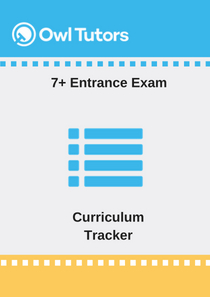7 Plus Curriculum
Download the Owl Tutors 7 Plus Curriculum Tracker here:

The 7 plus is a heterogeneous collection of admission tests to various independent schools for entry into year 3 in the United Kingdom. As these tests are not standardised and every school is free to set their own exam, defining a curriculum to cover the entire 7 plus is challenging. Having said this, given the age of the applicants, the relative subject knowledge and skills that can be expected from children of this age, one can make a well-educated guess as to what a 7 plus exam will cover. This is what we have done here to assist tutors and parents that are preparing their students for the 7 plus test.
After having consistently prepared students for 7 plus exams since their rapid increase in popularity in the late noughties, feedback from our tutors, students and clients have suggested that 7 plus exams to competitive schools expect students to be operating approximately one year ahead of national averages at the time they take the exam (November to January). As such, we have distilled the expectations in English, Maths and Interpersonal skills from the United Kingdom’s National Curriculum that students are expected to be achieving by the end of year 3 to create what successful 7 plus students should be able to complete half way through year 2. We then cross-referenced this list of learning objectives with various 7 plus sample exams published on independent school websites in order to refine the list of objectives.
As a result of this exercise, the list of learning objectives below represent what we currently feel students should be able to perform in order to be successful at 7 plus. We would like to emphasise however that even by being able to demonstrate aptitude in all of these learning objectives will not provide a guarantee of success in these competitive school entrance exams. Please also note that a student may not need to show aptitude in all of these learning objectives upon sitting the test and that the learning objectives laid out below are exceptionally high expectations for a student to achieve in year 2!